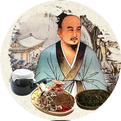Ancient practitioners, through long-term observation and reasoning, believed that the three Yin and three Yang meridians of the hands and feet communicate with each other through their respective channels and collaterals, forming six pairs of interrelated yet relatively independent relationships of Qi and blood circulation. As stated in the Su Wen (Plain Questions) · Xue Qi Xing Zhi (Blood and Qi, Form and Will), “The Foot Taiyang (Bladder) and Shaoyin (Kidney) are exterior and interior, the Shaoyang (Gallbladder) and Jueyin (Pericardium) are exterior and interior, the Yangming (Stomach) and Taiyin (Spleen) are exterior and interior, which constitutes the Yin and Yang of the foot. The Hand Taiyang (Small Intestine) and Shaoyin (Heart) are exterior and interior, the Shaoyang (Triple Burner) and Xin Zhu (Heart Master) are exterior and interior, the Yangming (Large Intestine) and Taiyin (Lung) are exterior and interior, which constitutes the Yin and Yang of the hand.” They are as follows:
Exterior: Hand Yangming (Large Intestine) Meridian, Interior: Corresponds with Hand Taiyin (Lung) Meridian.
Hand Shaoyang (Triple Burner), Corresponds with Hand Jueyin (Pericardium) Meridian.
Hand Taiyang (Small Intestine) Meridian, Corresponds with Hand Shaoyin (Heart) Meridian.
Foot Yangming (Stomach) Meridian, Corresponds with Foot Taiyin (Spleen) Meridian.
Foot Shaoyang (Gallbladder) Meridian, Corresponds with Foot Jueyin (Liver) Meridian.
Foot Taiyang (Bladder) Meridian, Corresponds with Foot Shaoyin (Kidney) Meridian.
Each of these pairs of meridians serves as exterior and interior connections, intersecting at the extremities of the limbs, and circulating in corresponding positions on the inner and outer aspects of the limbs (the Foot Jueyin (Liver) Meridian and Foot Taiyin (Spleen) Meridian cross and exchange positions below the tip of the inner ankle at eight cun). They each belong to the corresponding Zang (organs) and Fu (bowels) of their respective exterior and interior, with Yin meridians belonging to Zang and Yang meridians belonging to Fu. For example, the Foot Taiyin (Spleen) Meridian belongs to the Spleen and connects with the Stomach, while the Foot Yangming (Stomach) Meridian belongs to the Stomach and connects with the Spleen, etc. This not only strengthens the connection between the exterior and interior meridians but also stimulates and promotes the physiological functions of the corresponding Zang and Fu in a coordinated manner. However, the pathological interactions between the Zang and Fu of the meridians can also influence each other; for instance, if the Taiyin (Lung) Meridian is affected by pathogenic factors, it can lead to dysfunction in the Yangming (Large Intestine) Meridian, resulting in constipation. Excessive heart fire can descend through the meridian to the Small Intestine, causing painful urination and hematuria. Therefore, in treatment, one can apply the principle of communication between the exterior and interior meridians to adopt methods of treating Zang diseases with Fu treatments and vice versa, as well as using acupuncture points from the corresponding exterior and interior meridians for treatment.

